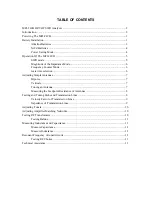
MFJ-249B Instruction Manual
HF/VHF SWR Analyzer
10
ADJUSTING TUNERS
The MFJ-249B can be used to adjust tuners. Connect the MFJ-249B "ANTENNA" connector to
the tuner's 50 ohm input and the desired antenna to the normal tuner output. This connection can
be made with a manual RF switch to facilitate rapid changeover.
WARNING
: Always connect the common (rotary contact) of the switch to the tuner. The
switch must connect either the MFJ-249B or the station equipment to the tuner.
The Station Equipment Must Never Be Connected To The MFJ-249B.
1.
Connect the MFJ-249B to the tuner input.
2.
Turn on the MFJ-249B and adjust it to the desired frequency.
3.
Adjust the tuner until the SWR becomes unity (1:1).
4.
Turn off the MFJ-249B and re-connect the transmitter.
ADJUSTING AMPLIFIER MATCHING NETWORKS
The MFJ-249B can be used to test and adjust RF amplifiers or other matching networks without
applying operating voltages.
The tubes and other components should be left in position and connected so that stray
capacitance is unchanged. A non-inductive resistor that equals the approximate driving
impedance of the tube is installed between the cathode of the tube and the chassis, or a resistor
should be connected between the anode and the chassis that equals the calculated plate
impedance of the tube. The appropriate network can now be adjusted.
The antenna relay (if internal) can be engaged with a small power supply so that the coax input
and output connectors are tied to the networks.
CAUTION
:
The driving impedance of most amplifiers changes as the drive level is varied.
Do not attempt to adjust the input network with the tube in an operating
condition with the low level of RF from the MFJ-249B.
TESTING RF TRANSFORMERS
RF transformers that are designed with a 50 ohm winding can be easily and accurately tested
with the MFJ-249B.
The 50 ohm winding is connected through a short 50 ohm cable to the "ANTENNA" connector
on the MFJ-249B. The other winding(s) of the transformer is then terminated with a low
inductance resistor that is equal to the windings impedance. The MFJ-249B can then be swept
through the desired transformer frequency range. The SWR and bandwidth of the RF
transformer can be measured.














